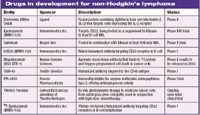Non-Hodgkin's lymphoma: Is cure possible?
Curing non-Hodgkin's lymphoma (NHL) is a formidable task, but clinicians and researchers are rapidly assembling the tools to do it. Over the past decade, our understanding of the disease process has progressed to the molecular level?allowing the development of new therapeutic options with the potential to precisely target therapy to the lymphomas?paving the way for longer remissions; fewer side effects; and, for increasingly more patients, cures. Research is progressing at a dizzying pace?at least 200 U.S. clinical trials are enrolling NHL patients.

NHL is the sixth most common cancer in the United States today. Between 1976 and 2001, its age-adjusted incidence rose by 71%, an annual percentage increase of nearly 2.6%. Although some statistics show the increase in new cases of NHL is leveling off, in 2004, about 54,000 new cases were diagnosed. Business analysts estimate that with its expanding patient base, the NHL market is capable of generating revenues of $2 billion to $5 billion per year, and several manufacturers are pursuing effective drug therapies for it.
As a diagnosis, NHL is considered an umbrella term, representing a diverse group of diseases that originate in the lymphatic system. "NHL is primarily distinguished by cell-surface receptor markers and cell types," explained Rebecca Finley, Pharm.D., president of Meniscus Educational Institute, West Conshohocken, Pa., a continuing medical education firm specializing in oncology. "Depending upon the lineage, different types behave in very different ways clinically. Some grow rapidly and will rapidly progress to [patient] death if not treated-for example, diffuse lymphomas. Others are more slow-growing, such as follicular or nodular lymphomas. However, they may be less responsive to conventional cytotoxic agents." While patients may live many years with these slow-growing cancers, they are more difficult to cure.
Finley commented, "Rituximab [Rituxan, Genentech/IDEC] is the first good example of a real targeted therapy for lymphomas, and several other therapies are in the pipeline." Rituximab was approved in 1997 to treat relapsed or refractory indolent or follicular CD20+ lymphomas. More recently, however, preliminary results of a phase III trial in indolent NHL suggested that rituximab has utility beyond induction as a maintenance therapy to enhance the length of remission. Preliminary results of another phase III trial in aggressive NHL have shown combining rituximab with CHOP (cyclophosphamide, doxorubicin, vincristine, and prednisone) or CHOP-like chemotherapy offers an improvement in time to treatment failure in comparison with standard therapy.
And rituximab has been a prelude to other monoclonal antibody (MA) therapies. Al Hester, an analyst with Technical Insights, a business unit of Frost & Sullivan, noted, "Most of the new lymphoma therapies under development are MAs. These antibodies are high-priced proteins, expensive to manufacture, and also inconvenient to administer to the patients." Antigens being targeted include CD20, CD4, CD22, and CD30.
Radioimmunotherapy has capitalized on the specificity of MAs to target radiation doses. Finley commented, "Radioimmunotherapy has been such an incredible advance in follicular lymphoma." More than 90% of patients diagnosed with this B-cell lymphoma have disseminated disease at diagnosis. Although current treatments are effective in controlling the disease temporarily, perhaps even for years, the median overall survival from the time of diagnosis is eight years.